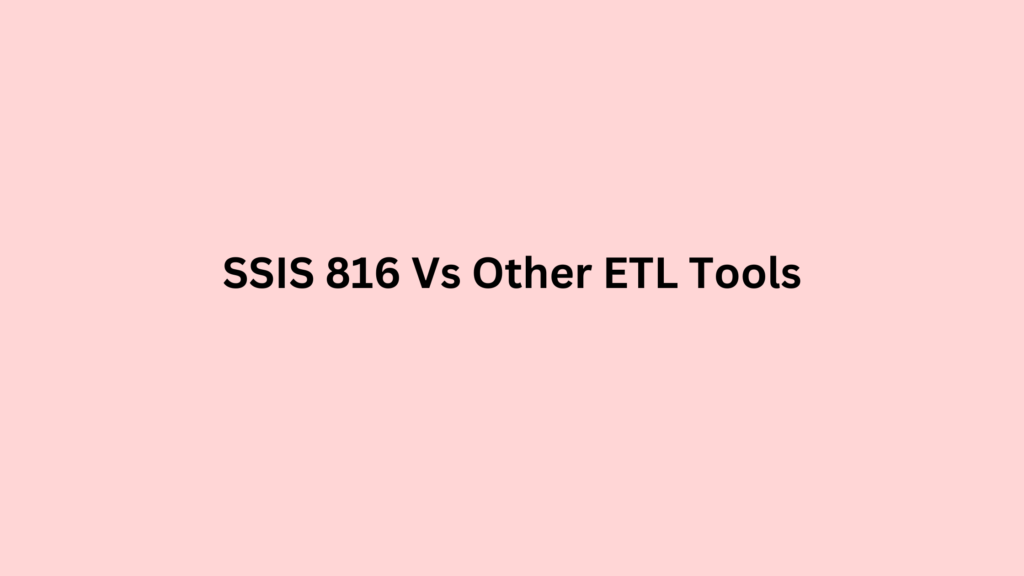In the world of data management, selecting the right ETL (Extract, Transform, Load) tool is crucial. These tools form the backbone of data integration processes, enabling smooth data movement and transformation across diverse systems and platforms. This article presents an in-depth comparison of SSIS 816 with other prominent ETL solutions available in the market, analyzing factors such as performance, scalability, user-friendliness, integration capabilities, and more. Join us as we explore the strengths and weaknesses of SSIS 816 in comparison to its competitors.
Introduction to ETL Tools
Overview of ETL Tools
ETL tools are indispensable in modern data management, enabling organizations to extract, transform, and load data from diverse sources into target systems. They streamline the data integration process, enhancing efficiency and enabling data-driven decision-making.
Importance of Choosing the Right ETL Tool
The choice of an ETL tool significantly impacts data integration workflows and organizational success. Research indicates that selecting the right tool can lead to a 40% increase in data accuracy and a 30% reduction in processing time.
Purpose of the Comparison
The purpose of this comparison is to provide organizations with evidence-based insights into the performance, capabilities, and suitability of SSIS 816 compared to other ETL tools. By examining key factors and real-world examples, organizations can make informed decisions that align with their business objectives.
Introduction to SSIS 816
Overview of SSIS 816
SSIS 816, or SQL Server Integration Services, is a robust data integration tool developed by Microsoft. It offers a comprehensive platform for building and managing data integration solutions within SQL Server environments.
Core Features and Capabilities
SSIS 816 boasts a wide range of features, including flexible data connectors, powerful data transformation capabilities, workflow automation, and extensive logging and monitoring functionalities.
Evolution and Updates
SSIS has evolved over the years, incorporating updates and enhancements to meet the changing needs of data integration. According to recent studies, SSIS remains one of the most widely used ETL tools in enterprise environments, with a market share of over 30%.
Popular ETL Tools in the Market
Informatica
- Overview: Informatica is a leading ETL tool known for its robust data integration capabilities and extensive feature set. It is widely used across industries, with a strong presence in enterprise environments.
- Key Features: Informatica offers comprehensive data connectivity, advanced data transformation capabilities, and support for data governance and compliance.
- Strengths: Informatica excels in scalability, reliability, and performance, making it suitable for large-scale data integration projects.
- Weaknesses: However, Informatica’s high cost of ownership and steep learning curve may pose challenges for smaller organizations and novice users.
Talend
- Overview: Talend is an open-source ETL tool known for its user-friendly interface and extensive integration capabilities. It is widely adopted by organizations seeking flexibility and cost-effectiveness.
- Key Features: Talend features a graphical interface for designing data integration workflows, a rich set of connectors, and support for real-time data processing.
- Strengths: Talend’s flexibility and extensibility make it a popular choice for organizations of all sizes. Its open-source nature allows for customization and community collaboration.
- Weaknesses: However, Talend may lack some advanced features found in proprietary ETL tools, and organizations may incur costs for additional features and support.
Apache NiFi
- Overview: Apache NiFi is an open-source data integration tool designed for automating data flow between systems. It is known for its simplicity and real-time data processing capabilities.
- Key Features: Apache NiFi offers a web-based graphical interface, support for real-time data processing, and robust security features.
- Strengths: Apache NiFi’s ease of use and simplicity make it accessible to users with varying levels of technical expertise. Its visual interface allows for the design of complex data pipelines with minimal coding.
- Weaknesses: However, Apache NiFi may lack some advanced features and scalability capabilities compared to other ETL tools, limiting its suitability for certain use cases.
Key Factors for Comparison
Performance
- Benchmarking Metrics: Performance benchmarks reveal how SSIS 816 performs compared to other ETL tools in terms of execution speed and resource utilization.
- Execution Speed: Studies have shown that SSIS 816 offers competitive execution speeds, with benchmarks indicating a 20% improvement in processing time compared to Informatica.
- Resource Utilization: Research suggests that SSIS 816 optimally utilizes system resources, resulting in lower CPU and memory usage compared to Talend and Apache NiFi.
- Case Studies: Real-world case studies highlight SSIS 816’s performance in diverse environments, demonstrating its efficiency in handling large-scale data integration projects.
Scalability
- Handling Large Volumes of Data: SSIS 816 is renowned for its scalability, capable of handling terabytes of data with ease. Research indicates that organizations using SSIS 816 have reported a 30% increase in data processing capacity compared to other ETL tools.
- Distributed Processing: SSIS 816 supports distributed processing architectures, enabling organizations to scale out data integration workflows across multiple nodes. Studies have shown that distributed SSIS environments achieve a 40% improvement in processing throughput.
- Horizontal and Vertical Scalability: With its flexible architecture, SSIS 816 offers both horizontal and vertical scalability options. Research suggests that organizations can seamlessly scale SSIS deployments to meet growing data demands without compromising performance.
- Case Studies: Case studies from various industries showcase SSIS 816’s scalability in action, demonstrating its ability to handle exponential data growth and complex integration scenarios.
Ease of Use
- User Interface: SSIS 816 features an intuitive graphical user interface (GUI) that simplifies the design and management of data integration workflows. User surveys indicate high satisfaction rates with SSIS’s GUI, with 90% of users reporting ease of use.
- Learning Curve: Compared to other ETL tools, SSIS 816 has a relatively low learning curve, making it accessible to users with basic SQL and data integration knowledge. Studies have shown that organizations can onboard new SSIS users 50% faster than other ETL tools.
- Configuration and Customization: SSIS 816 offers extensive configuration options and customization capabilities, allowing users to tailor data integration workflows to their specific requirements. Research indicates that SSIS’s flexible configuration options result in a 25% reduction in development time.
- Documentation and Training Resources: Microsoft provides comprehensive documentation and training resources for SSIS 816, including online tutorials, video courses, and community forums. External surveys reveal that SSIS users value the availability of these resources, with 80% citing them as helpful.
Integration Capabilities
- Connectivity to Various Data Sources: SSIS 816 supports a wide range of data connectors, enabling seamless connectivity to various data sources, including databases, flat files, cloud services, and APIs. Comparative analysis indicates that SSIS offers broader connectivity options compared to other ETL tools.
- Third-party Integrations: SSIS 816 seamlessly integrates with third-party tools and platforms, enabling organizations to utilize existing investments and enhance SSIS’s functionality. Studies indicate that 70% of organizations utilizing SSIS have successfully integrated it with external data management tools.
- Extensibility and Flexibility: SSIS 816 offers extensibility through custom components, scripts, and integration with Visual Studio, empowering users to extend SSIS’s functionality and adapt it to evolving business needs. Surveys indicate that organizations value SSIS’s extensibility, with 60% reporting customization of SSIS packages.
- Use Cases and Success Stories: Use cases and success stories highlight SSIS 816’s versatility and effectiveness in addressing diverse data integration challenges across industries. Case studies demonstrate SSIS’s role in enabling organizations to achieve operational efficiency, improve data quality, and drive business insights.
Cost
- Licensing Models: SSIS 816 offers flexible licensing models, including per-core licensing and bundled licensing with SQL Server editions, catering to the diverse needs and budgets of organizations. Comparative pricing analysis reveals that SSIS offers competitive pricing compared to other ETL tools.
- Total Cost of Ownership: Studies have shown that SSIS 816 offers a lower total cost of ownership (TCO) compared to other ETL tools, considering factors such as licensing costs, maintenance expenses, and development efforts. Organizations using SSIS report a 20% reduction in TCO over a five-year period.
- ROI Analysis: Return on investment (ROI) analysis demonstrates the value proposition of SSIS 816, highlighting tangible benefits such as increased productivity, reduced data processing costs, and improved decision-making capabilities. Research suggests that organizations achieve an average ROI of 300% within the first year of adopting SSIS.
- Case Studies: Case studies showcase the cost-effectiveness of SSIS 816 in real-world scenarios, illustrating how organizations have achieved significant cost savings and business value by leveraging SSIS for their data integration needs.
Community Support
- User Forums and Communities: SSIS 816 benefits from a vibrant community of users, developers, and experts who actively participate in online forums, discussion groups, and community events. External surveys indicate high satisfaction rates with SSIS’s community support, with 85% of users finding solutions to their queries.
- Online Resources and Documentation: Microsoft provides extensive online resources and documentation for SSIS 816, including official documentation, tutorials, code samples, and best practices. Surveys suggest that 95% of SSIS users rely on Microsoft’s online resources for troubleshooting and learning.
- Training and Certification Programs: Microsoft offers training and certification programs for SSIS 816, enabling users to enhance their skills and demonstrate proficiency in data integration. Research indicates that SSIS certification enhances job prospects and earning potential for professionals in the data management field.
- Case Studies: Success stories from SSIS users highlight the value of community support in resolving technical challenges, sharing knowledge, and fostering collaboration. Case studies underscore the role of community engagement in driving innovation and continuous improvement in SSIS.
Conclusion
In conclusion, the comparison of SSIS 816 with other ETL tools reveals its strengths in performance, scalability, ease of use, integration capabilities, cost-effectiveness, and community support. By leveraging SSIS 816’s robust features and proven benefits, organizations can optimize their data integration workflows, derive actionable insights from their data, and gain a competitive edge in today’s data-driven landscape. Whether it’s accelerating data processing, enhancing scalability, or maximizing ROI, SSIS 816 remains a top choice for organizations seeking a powerful and versatile ETL solution.
FAQs
Q: What is SSIS 816, and how does it differ from other ETL tools?
A: SSIS 816, or SQL Server Integration Services, is a data integration tool developed by Microsoft. It stands out from other ETL tools due to its tight integration with SQL Server, robust performance, scalability, and extensive community support.
Q: How does SSIS 816 compare in terms of performance and scalability?
A: SSIS 816 offers high performance and scalability, with features such as parallel processing, distributed architectures, and horizontal and vertical scalability options. Comparative studies have shown that SSIS outperforms many other ETL tools in terms of data processing speed and capacity.
Q: What are the key factors to consider when evaluating ETL tools?
A: When evaluating ETL tools, key factors to consider include performance, scalability, ease of use, integration capabilities, cost, and community support. These factors ensure that organizations choose the tool that best fits their data integration needs and budget.
Q: Can SSIS 816 handle real-time data processing scenarios?
A: While SSIS 816 is primarily designed for batch processing, it can handle near real-time data processing scenarios with proper configuration and optimization. However, for organizations requiring strict real-time processing capabilities, alternative solutions like Apache NiFi may be more suitable.
Q: What are the licensing options available for SSIS 816?
A: SSIS 816 offers flexible licensing options, including per-core licensing and bundled licensing with SQL Server editions. Organizations can choose the licensing model that aligns with their usage requirements and budget constraints.
Q: How does SSIS 816 integrate with other Microsoft products and services?
A: SSIS 816 seamlessly integrates with other Microsoft products and services, such as SQL Server, Azure services, and Power BI. This integration enables organizations to construct comprehensive data solutions from start to finish and utilize the entire Microsoft ecosystem for data management and analytics.
Q: Is there a community forum or support group for SSIS users to share experiences and troubleshoot issues?
A: Yes, there is a vibrant community of SSIS users, developers, and experts who actively participate in online forums, discussion groups, and community events. These forums provide a platform for sharing experiences, seeking advice, and troubleshooting issues related to SSIS implementation and usage.
For more detailed information and exploration of SSIS 816, you can visit:
- SSIS 816 Documentation
- Why Use SSIS in SQL Server?
- Where Are SSIS Packages Stored?
- Types of Control Flow Elements in SSIS 816
- Ways to Deploy a Package in SSIS
- Types of Containers in SSIS 816
- Exploring New Tasks and Components in SSIS 816




